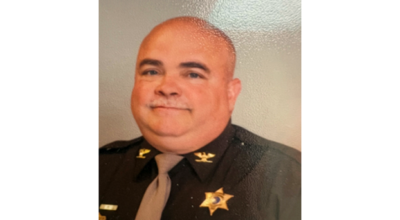Pop culture provides a cathartic release
Published 9:44 am Tuesday, February 2, 2016
Mutual obsession with “The Walking Dead” recast Dr. Maria DeRose’s and Natalie Anagnos’ relationship from Humanities and Communication colleagues to teacher and student.
DeRose, a “pop culture addict,” teaches the topic.
Anagnos, English and Spanish instructor and “pop culture newbie,” flourished feeding her fandom with new knowledge about cinematography and zeitgeist.
Entertainment is but one room of a house they guided a tour of Jan. 26 kicking off Southwestern Michigan College’s spring academic lecture series in the theatre of the Dale A. Lyons Building on the Dowagiac campus.
Matching wristbands attest to devotion to their favorite character, crossbow-carrying Daryl Dixon (Norman Reedus) from the horror-drama AMC television series inspired by comic books that also spawned 2015’s “Fear the Walking Dead” set in Los Angeles.
If Daryl dies, “We’re done,” Anagnos vows.
Showrunner Scott Gimple says Daryl is “very scary in this back half (of season six returning Feb. 14) … There is a whole lot of Daryl and a wide variety of Daryl.”
“I started watching when it premiered Oct. 31, 2010. I absolutely fell in love with ‘The Walking Dead,’” Anagnos said. “I posted memes on Facebook, then something unusual happened. Friends gave me all sorts of grief: ‘You’re smart. I’m surprised you’d waste your time.’ That got me thinking about why. Maria is an expert in pop culture and film and taught me about cinematography. Now, when people give me a hard time, I can explain why I like it. My friends and family who listen to my 10-minute spiels rue the day they brought it up.”
DeRose, her dissertation rooted in science fiction, applied academic terminology, crystallizing Anagnos’ avid attention to the zombie apocalypse.
“Film, television, graphic novels, anime — entertainment stuff — are just part of pop culture,” DeRose said. “Another room is rites and rituals, like baby showers or Super Bowl parties. We look at heroes, real like George Washington and imaginary like Superman, and icons that visually represent America.”
Concrete and transitory beliefs solidify the House of Pop Culture foundation.
“Concrete values like independence never change,” DeRose said. “Transitory beliefs adapt about every 10 years, like how we feel about equality, technology, the government, immigration, parenting and education. Zeitgeist taps into transitory beliefs for the common thread” yielding nicknames such as the 1950s Age of Conformity, the ’60s Age of Rebellion, the ’70s Age of Free Love and the ’80s Age of Greed.”
Central to understanding “The Walking Dead” is “everyone is already infected. Anyone has the potential to become a zombie,” DeRose said. “ ‘Monsters’ are people we know, like Merle. It is very good at familiar things with genre twists,” such as Western elements like an extreme long shot of Grimes clip-clopping along a desolate highway on horseback toward the decimated Atlanta skyline.
Cowboy loners ride into scenes from left to right, bridging Western wilderness and Eastern civilization.
“With enemies within, you don’t know whom to trust, like the San Bernardino shootings,” DeRose said. “Pop culture taps into our fears and lets us have a cathartic release from anxiety. It’s also very good at bringing in archetypal characters. Glenn (Rhee, played by Kalamazoo College graduate Stephen Yeun) is that hero from nowhere.”
The pizza deliverer’s familiarity with the street system adds value.
“Let’s get over stereotypes,” DeRose said. “One thing I love about this show is there is no damsel in distress.”
“Cinematography is the way we present what we film to our audience for some type of reaction,” said Anagnos, whose favorite scene was the fourth-season masking shot of Grimes hiding under a bed.
“Rick loses his innocence. He took an oath of office to serve and protect his community,” Anagnos said. “When we first met him, he was in the hospital in a coma. As he recovers he wants to find his wife and son Carl and recreate home, which is gone. Every time they find safe haven, it’s overtaken. Rick adapts by becoming a monster and a dictator. I’m worried about Rick. No character is safe. There is no rest for these people.”
“My second-favorite character is Carol (Peletier, played by Melissa McBride),” Anagnos said. “She was a victim of domestic abuse. When her husband and daughter die, she turns into one of the most badass characters on the show, a tough broad who looks like a soccer mom and bakes cookies, but sees threats down the road and kills liabilities, taking out a child who killed her sister” before that girl can harm baby Judith.
Sunday night shows, followed by “Talking Dead” with host Chris Hardwick and a panel of cast members and celebrity fans dissecting developments, create watch parties.
“It’s interesting that a show about the collapse of civilization can bring us together in the real world,” DeRose said.
The series continues with immigration author Dr. Christina Gerken Feb. 10, Andrews University Chaplain Michael Polite Feb. 18 for Black History Month, FBI Special Agent Jeff Brown March 1, John Low on the Pokagon Band and Chicago March 17 and Dr. Jeff Dennis and Director of Choral Activities David Carew on “The Star-Spangled Banner” April 13.
About Southwestern Michigan College
Southwestern Michigan College is a public, residential and commuter, community college, founded in 1964. The college averages in the top 10 percent nationally for student academic success based upon the National Community College Benchmark Project. Southwestern Michigan College strives to be the college of first choice, to provide the programs and services to meet the needs of students, and to serve our community. The college is accredited by The Higher Learning Commission of the North Central Association of Colleges and Schools and is a member of the American Association of Community Colleges.







